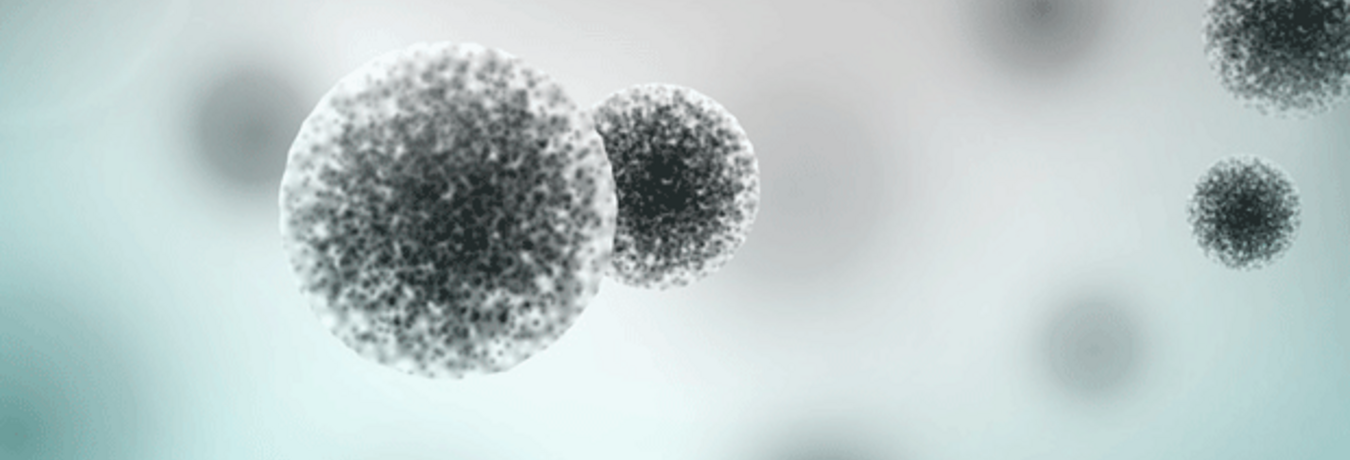Aufgaben
Chlamydien
Chlamydien sind obligat intrazelluläre Bakterien, die sich v.a. in Epithelzellen der Konjunktiva, des Respirations- und Genitaltraktes vermehren. Die wichtigsten humanpathogenen Vertreter sind Chlamydia (C.) trachomatis (häufigstes sexuell übertragenes Bakterium), C. pneumoniae (Verursacher respiratorischer Infektionen), C. psittaci und C. abortus (Erreger von Zoonosen).
Forschungsschwerpunkte
Die Arbeitsgruppe befasst sich seit Jahren mit der Erforschung der verschiedenen humanmedizinisch bedeutsamen Chlamydieninfektionen. Neben der infektionsimmunologischen und ultramorphologischen Charakterisierung der Erreger/Wirt-Interaktion in Zelllinien und primären humanen Zellen, steht insbesondere die Identifikation und Erforschung diagnostisch wertvoller Antigene im Zentrum des Interesses. Durch serologische Proteomanalysen, das Screening eigens etablierter Expressionsgenbanken und die rekombinante Herstellung chlamydialer Proteinantigene konnten Kandidaten für neue serologische Testverfahren identifiziert werden. Unter ihnen werden derzeit v.a. putative, Typ-III-sezernierte Virulenzfaktoren hinsichtlich ihrer funktionellen Relevanz, der subzellulären Lokalisation und Expression weiter untersucht.
Publikationen
ausgewählte Publikationen zu Chlamydia spp.
- Diensthuber D, Simnacher U, Peters S, Walther P, Essig A, Hagemann JB. Clearing Chlamydia abortus infection in epithelial cells and primary human macrophages by use of antibiotics and the MDM2-p53-inhibitor nutlin-3. Diagn Microbiol Infect Dis. 103(3):115715. doi: 10.1016/j.diagmicrobio.2022.115715 (2022)
- Marschall MT, Simnacher U, Walther P, Essig A, Hagemann JB. The Putative type III secreted Chlamydia abortus virulence-associated protein CAB063 targets lamin and induces apoptosis. Front Microbiol. 11:1059. doi: 10.3389/fmicb.2020.01059 (2020)
- Hagemann JB, Simnacher U, Marschall MT, Maile J, Soutschek E, Wellinghausen N, Essig A. Analysis of humoral immune responses to recombinant Chlamydia pneumoniae antigens. Int J Infect Dis. 91:232-9. doi: 10.1016/j.ijid.2019.12.007 (2020)
- Hagemann JB, Simnacher U, Longbottom D, Livingstone M, Maile J, Soutschek E, Walder G, Boden K, Sachse K, Essig A. Analysis of humoral immune responses to surface and virulence-associated Chlamydia abortus proteins in ovine and human abortions by use of a newly developed line immunoassay. J Clin Microbiol. 54(7):1883-90. doi: 10.1128/JCM.00351-16 (2016)
- Essig A, Longbottom D.Chlamydia abortus: New aspects of infectious abortion in sheep and potential risk for pregnant women. Curr Clin Micro Rpt. 2:22-34. doi: 10.1007/s40588-015-0014-2 (2015)
- Gaydos C, Essig A.Chlamydiaceae. In: Jorgensen JH, Pfaller MA, Carroll KC, Funke G, Landry ML, Richter SS, Warnock DW, editors. Manual of Clinical Microbiology. Washington DC: ASM Press; 2015. pp. 1106-21.
- Frickmann H, Essig A, Poppert S. Identification of lymphogranuloma venereum-associated Chlamydia trachomatis serovars by fluorescence in situ hybridisation--a proof-of-principle analysis. Trop Med Int Health. 19(4):427-30. doi: 10.1111/tmi.12271 (2014)
- Wilkat M, Herdoiza E, Forsbach-Birk V, Walther P, Essig A. Electron tomography and cryo-SEM characterization reveals novel ultrastructural features of host-parasite interaction during Chlamydia abortus infection. Histochem Cell Biol. 142(2):171-84. doi: 10.1007/s00418-014-1189-y (2014)
- Forsbach-Birk V, Foddis C, Simnacher U, Wilkat M, Longbottom D, Walder G, Benesch C, Ganter M, Sachse K, Essig A. Profiling antibody responses to infections by Chlamydia abortus enables identification of potential virulence factors and candidates for serodiagnosis. PLoS One. 8(11):e80310. doi: 10.1371/journal.pone.0080310 (2013)
- Fieser N, Simnacher U, Tausch Y, Werner-Belak S, Ladenburger-Strauss S, von Baum H, Reischl U, Essig A.Chlamydia trachomatis prevalence, genotype distribution and identification of the new Swedish variant in Southern Germany. Infection. 41(1):159-66. doi: 10.1007/s15010-012-0301-2 (2012)
- Bierbaum S, Konigsfeld N, Besazza N, Blessing K, Rucker G, Kontny U, Berner R, Schumacher M, Forster J, Falcone V, van de Sand C, Essig A, Huzly D, Rohde G, Neumann-Haefelin D, Panning M. Performance of a novel microarray multiplex PCR for the detection of 23 respiratory pathogens (SYMP-ARI study). Eur J Clin Microbiol Infect Dis. 31(10):2851-61. doi: 10.1007/s10096-012-1639-1 (2012)
- Yu H, Schwarzer K, Förster M, Kniemeyer O, Forsbach-Birk V, Straube E, Rödel J. Role of HMGB1 and PARP-1 degradation in Chlamydia trachomatis-induced cytopathicity. Infect Immun. 78(7):3288-97. doi: 10.1128/IAI.01404-09 (2010)
- Rohde G, Straube E, Essig A, Reinhold P, Sachse K. Chlamydial zoonoses. Dtsch Arztebl Int. 107:174-80. doi: 10.3238/arztebl.2010.0174 (2010)
- Forsbach-Birk V, Simnacher U, Pfrepper KI, Soutschek E, Kiselev AO, Lampe MF, Meyer T, Straube E, Essig A. Identification and evaluation of a combination of chlamydial antigens to support the diagnosis of severe and invasive Chlamydia trachomatis infections. 16(8):1237-44. doi: 10.1111/j.1469-0691.2009.03041.x (2009)
- Siemer J, Theile O, Larbi Y, Fasching PA, Danso KA, Kreienberg R, Essig A.Chlamydia trachomatis infection as a risk factor for infertility among women in Ghana, West Africa. Am J Trop Med Hyg. 78(2):323-7 (2008)
- Wellinghausen N, Straube E, Freidank H, von Baum H, Marre R, Essig A. Low prevalence of Chlamydia pneumoniae in adults with community-acquired pneumonia. Int J Med Microbiol. 296:485-91. doi: 10.1016/j.ijmm.2006.05.003 (2006)
- Poppert S, Schlaupitz K, Marre R, Voisard R, Roessler W, Weckermann D, Weingärtner K ,Essig A.Chlamydia pneumoniae in an ex vivo human artery culture model. Atherosclerosis. 187(1):50-6. doi: 10.1016/j.atherosclerosis.2005.08.029 (2006)
- Collingro A, Poppert S, Heinz E, Schmitz-Esser S, Essig A, Schweikert M, Wagner M, Horn M. Recovery of an environmental Chlamydia strain from activated sludge by co-cultivation with Acanthamoeba spp. Microbiology. 151(Pt 1):301-9. doi: 10.1099/mic.0.27406-0 (2005)
- Rampf J, Essig A, Hinrichs R, Merkel M, Scharffetter-Kochanek K, Sunderkotter C. Lymphogranuloma venereum - a rare cause of genital ulcers in central Europe. Dermatology. 209(3):230-2. doi: 10.1159/000079896 (2004)
- Schütt S, Essig A. Diagnostik von Chlamydieninfektionen. J Lab Med. 28(2):144-53 (2004)
- Reischl U, Lehn N, Simnacher U, Marre R, Essig A. Rapid and standardized detection of Chlamydia pneumoniae using LightCycler real-time fluorescence PCR. Eur J Clin Microbiol Infect Dis. 22(1):54-7. doi: 10.1007/s10096-002-0858-2 (2003)
- Wahl C, Maier S, Marre R, Essig A. 2003. Chlamydia pneumoniae induces the expression of inhibitor of apoptosis 2 (c-IAP2) in a human monocytic cell line by an NF-kappaB-dependent pathway. Int J Med Microbiol. 293(5):377-81. doi: 10.1078/1438-4221-00274
- Poppert S, Essig A, Marre R, Wagner M, Horn M. Detection and differentiation of chlamydiae by fluorescence in situ hybridization. Appl Environ Microbiol. 68(8):4081-9. doi: 10.1128/AEM.68.8.4081-4089.2002 (2002)
- Poppert S, Marre R, Essig A. 2001. Biology and clinical significance of chlamydiae. Contrib Microbiol. 8:51-71. doi: 10.1159/000060399 (2001)
- Wahl C, Oswald F, Simnacher U, Weiss S, Marre R, Essig A. Survival of Chlamydia pneumoniae-infected Mono Mac 6 cells is dependent on NF-kappaB binding activity. Infect Immun. 69(11):7039-45. doi: 10.1128/IAI.69.11.7039-7045.2001 (2001)
- Essig A, Heinemann M, Schweitzer R, Simnacher U, Marre R. Decontamination of a Mycoplasma-Infected Chlamydia pneumoniae Strain by Pulmonary Passage in SCID Mice. Int J Med Microbiol: 290(3):289-92. doi: 10.1016/S1438-4221(00)80130-7 (2000)
- Heinemann M, Kern W, Bunjes D, Marre R, Essig A. Severe Chlamydia pneumoniae infection in patients with neutropenia: Case reports and literature review. Clin Inf Dis. 31(1):181-4. doi: 10.1086/313905 (2000)
- Essig A, Simnacher U, Susa M, Marre R. Analysis of the humoral immune response to Chlamydia pneumoniae by immunoblotting and immunoprecipitation. Clin Diagn Lab Immunol. 6(6):819-25. doi: 10.1128/CDLI.6.6.819-825.1999 (1999)
- Thoma-Uszynski S, Simnacher U, Marre R, Essig A. Clearance of Chlamydia trachomatis induced polyserositis in SCID mice requires both CD4+ and CD8+ cells. Med Microbiol Immunol. 187(2):71-8. doi: 10.1007/s004300050076 (1998)
- Essig A, Heinemann M, Simnacher U, Marre R. Infection of Acanthamoeba castellanii by Chlamydia pneumoniae. Appl Environ Microbiol. 63(4):1396-9. doi: 10.1128/aem.63.4.1396-1399.1997 (1997)
- Heinemann M, Susa M, Simnacher U, Marre R, Essig A. Growth of Chlamydia pneumoniae induces cytokine production and expression of CD14 in a human monocytic cell line. Infect Immun. 64(11):4872-5. doi: 10.1128/iai.64.11.4872-4875.1996 (1996)
- Essig A, Rudolphi A, Heinemann M, Rosenthal H, Kaufmann R, Reimann J, Marre R. A model of genital Chlamydia trachomatis infection using human xenografts in severe combined immunodeficiency mice. Infect Immun. 64(6):2300-7. doi: 10.1128/iai.64.6.2300-2307.1996 (1996)
- Essig A, Zucs P, Susa M, Wasenauer G, Mamat U, Hetzel M, Wieshammer S, Brade H, Marre R. Diagnosis of ornithosis by cell culture and polymerase chain reaction in a patient with chronic pneumonia. Clin Infect Dis. 21(6):1495-7. doi: 10.1093/clinids/21.6.1495 (1995)
weitere ausgewählte Publikationen
- Furaijat G, Bettac L, Kächele M, Grüner B, Skrabal C, Barth TFE, Parlak M, Hagemann JB, Peters L, Walther G, Kersten J. An unusual presentation of invasive Fusarium aortitis in a patient who is immunocompromised: A case report. Int J Infect Dis. 134:102-5. doi: 10.1016/j.ijid.2023.05.069 (2023)
- Gloor S, Jiang W, Maurer MH, Gottstein B, Oberli A, Hagemann JB, Hotz F, Candinas D, Lachenmayer A, Grüner B, Beldi G. The trajectory of anti-recEm18 antibody levels determines follow-up after curative resection of hepatic alveolar echinococcosis. HPB (Oxford). S1365-182X(23)01948-2. doi: 10.1016/j.hpb.2023.10.007 (2023)
- Peters L, Jiang W, Eberhardt N, Hagemann JB, Grüner B, Tappe D. (18)FDG-PET/CT-scans and biomarker levels predicting clinical outcome in patients with alveolar echinococcosis - A single-center cohort study with 179 patients. Pathogens. 12(8):1041. doi: 10.3390/pathogens12081041 (2023)
- Staudacher M, Hotz JF, Kriz R, Schefberger K, Schneider L, Spettel K, Starzengruber P, Hagemann B, Leutzendorff A, Burgmann H, Lagler H. Differences in oxazolidinone resistance mechanisms and small colony variants emergence of Staphylococcus aureus induced in an in vitro resistance development model. Emerg Microbes Infect. 6:2292077. doi: 10.1080/22221751.2023.2292077 (2023)
- Schleenvoigt BT, Ankert J, Barten-Neiner G, Voit F, Suttorp N, Boesecke C, Hoffmann C, Stolz D, Pletz MW, Rode G, Witzenrath M, Panning M, Essig A, Rupp J, Degen O, Stephan C, CAPNETZ Study Group. Pathogen spectrum of community acquired pneumonia in people living with HIV (PLWH) in the German CAPNETZ-Cohort. Infection. doi: 10.1007/s15010-023-02070-3 (2023)
- Braeken DCW, Essig A, Panning M, Hoerster R, Nawrocki M, Dallhoff K, Suttorp N, Welte T, Pletz MW, Witzenrath M, Rohde GGU, Rupp J, CAPNETZ Study Group. Shift in bacterial etiology from the CAPNETZ cohort in patients with community-acquired pneumonia: data over more than a decade. Infection. 49(3):533-7. doi: 10.1007/s15010-021-01605-w (2021)
- Hotz JF, Peters L, Kapp-Schwörer S, Theis F, Eberhardt N, Essig A, Grüner B, Hagemann JB. Evaluation of serological markers in alveolar echinococcosis emphasizing the correlation of PET-CTI tracer uptake with recEm18 and Echinococcus-specific IgG. Pathogens. 11(2):239. doi: 10.3390/pathogens11020239 (2022)
- Peters L, Burkert S, Hagemann JB, Albes R, Klemptner J, Birkle J, Schwaibold E, Siefermann S, Grüner B. Initial risk assessment in patients with alveolar echinococcosis - Results from a retrospective cohort study. Pathogens. 11(5):557. doi: 10.3390/pathogens11050557 (2022)
- Abu-Rumeileh S, Garibashvili T, Hagemann JB, Still V, Bachhuber F, Otto M, Tumani H, Senel M. A one-year longitudinal evaluation of cerebrospinal fluid and blood neurochemical markers in a patient with cryptococcal meningitis complicated by ischemic stroke. J Neurol Sci. 15:432:120090. doi: 10.1016/j.jns.2021.120090 (2022)
- Haggenmüller B, Breining T, Kloth C, Schmidt SA, Huber M, Hagemann JB, Traub S, Vogele D. Lethal course due to an infectious soft tissue emphysema. Radiologe. 61(8):748-51. doi: 10.1007/s00117-021-00844-0 (2021)
- Louwen F, Wagner U, Abou-Dakn M, Dötsch J, Lawrenz B, Ehm D, Surbek D, Essig A, Greening M, Schäfers R, Mattern E, Waterstradt IC, Kästner R, Lütje W, Kranke P, Messroghli L, Wenk M, Kehl S, Schlößer R, Lüdemann K, Maier B, Misselwitz B, Heller G, Bosch A, Nielsen R, Rothe C, Sirsch E, Sctocker Kalberer B, Vogel T, von Kaisenberg C, Nothacker M, Hülsewiesche B, Allert R, Jennewein L. Caesarean Section. Guideline of the DGGG, OEGGG and SGGG (S3-Level, AWMF Registry No. 015/084, June 2020). Geburtshilfe Frauenheilkd. 81(8):896-921. doi: 10.1055/a-1529-6141 (2021)
- Dähne T, Bauer W, Essig A, Schaaf B, Spinner CD, Pletz MW, Rohde G, Rupp J, Witzenrath M, Panning M, CAPNETZ Study Group. The impact of the SARS-CoV-2 pandemic on the prevalence of respiratory tract pathogens in patients with community-acquired pneumonia in Germany. Emerg Microbes Infect. 10(1):1515-8. doi: 10.1080/22221751.2021.1957402 (2021)
- Rothe K, Spinner CD, Panning M, Pletz MW, Rohde G, Rupp J, Witzenrath M, Erber J, Eberhardt F, Essig A, Schneider J, CAPNETZ Study Group. Evaluation of a multiplex PCR screening approach to identify community-acquired bacterial co-infections in COVID-19: A multicenter prospective cohort study of the German competence network of community-acquired pneumonia (CAPNETZ). Infection. 49(6):1299-1306. doi: 10.1007/s15010-021-01720-8 (2021)
- Hagemann JB, Furitsch M, Wais V, Bunjes D, Walther G, Kurzai O, Essig A. First case of fatal Rhizomucor miehei endocarditis in an immunocompromised patient. Diagn Microbiol Infect Dis. 98(2):115106. doi: 10.1016/j.diagmicrobio.2020.115106 (2020)
- Groß R, Bauer R, Krüger F, Rücker-Braun E, Olari LR, Ständker L, Preising N, Rodríguez AA, Conzelmann C, Gerbl F, Sauter D, Kirchhoff F, Hagemann B, Gacanin J, Weil T, Ruiz-Blacno YB, Sanchez-Garcia E, Forssmann WG, Mankertz A, Santibanez S, Stenger S, Walther P, Wiese S, Spellerber B, Münch J. A placenta derived C-terminal fragment of β-hemoglobin with combined antibacterial and antiviral activity. Front Microbiol. 11:508. doi: 10.3389/fmicb.2020.00508 (2020)
- Spellerberg B, Rabsch W, Pietsch M, Denzer C, Posovszky C, Essig A, Pfeifer Y. Extended-spectrum β-lactamase acquisition in patients receiving systemic cephalosporin treatment for Salmonella spp. and Shigella spp. infection. Clin Infect Dis. 70(4):714-6. doi: 10.1093/cid/ciz468 (2020)
- Hagemann JB, Haverkamp S, Grüner B, Kuchenbauer F, Essig A. Pulmonary Campylobacter concisus infection in an immunocompromised patient with underlying mucormycosis. Int J Infect Dis. 76:45-7. doi: 10.1016/j.ijid.2018.08.021
- Hagemann JB, Pfennigwerth N, Gatermann SG, von Baum H, Essig A. KPC-2 carbapenemase-producing Pseudomonas aeruginosa reaching Germany. J Antimicrob Chemother. 73(7):1812-1814. doi: 10.1093/jac/dky105 (2018)
- Seufert R, Sedlacek L, Kahl B, Hogardt M, Hamprecht A, Haase G, Gunzer F, Haas A, Grauling-Halama S, MacKenzie CR, Essig A, Stehling F, Sutharsan S, Dittmer S, Killengray D, Schmidt D, Eskandarian N, Steinmann E, Buer J, Hagen F, Meis JF, Rath PM, Steinmann J. Prevalence and characterization of azole-resistant Aspergillus fumigatus in patients with cystic fibrosis: A prospective multicentre study in Germany. J Antimicrob Chemother. 73(8):2047-2053. doi: 10.1093/jac/dky147 (2018)
- Essig A, von Baum H, Gonser T, Härter G, Lück C. Microbiological diagnosis and molecular typing of Legionella strains during an outbreak of legionellosis in Southern Germany. Int J Med Microbiol. 306(2):109-14. doi: 10.1016/j.ijmm.2016.01.001 (2016)
- Hagemann JB, Essig A, Herrmann M, Liebold A, Quader MA. Early prosthetic valve endocarditis caused by Corynebacterium kroppenstedtii. Int J Med Microbiol. 305(8):957-9. doi: 10.1016/j.ijmm.2015.10.003 (2015)
- Lück C, Brzuszkiewicz E, Rydzewski K, Koshkolda T, Sarnow K, Essig A, Heuner K. Subtyping of the Legionella pneumophila "Ulm" outbreak strain using the CRISPR-Cas system. Int J Med Microbiol. 305(8):828-37. doi: 10.1016/j.ijmm.2015.08.001 (2015)
- Herrmann MD, Neumayr A, Essig A, Spiess J, Merk J, Möller P, Liebold A, Barth TFE. Isolated Whipple's endocarditis: An underestimated diagnosis that requires molecular analysis of surgical material. Ann Thorac Surg. 98(1):e1-3. doi: 10.1016/j.athoracsur.2014.04.059 (2014)
- Kleger A, Schnell J, Essig A, Wagner M, Bommer M, Seufferlein T, Härter G. Fecal transplant in refractory Clostridium difficile colitis. Dtsch Arztebl Int. 110(7):108-15. doi: 10.3238/arztebl.2013.0108 (2013)
- Frickmann H, Hänle A, Essig A, Dekker D, Boahen K, Acquah S, Sarpong N, Adu-Sarkodie Y, Schwarz NG, May J, Marks F, Hagen RM, Poppert S. Fluorescence in situ hybridization (FISH) for rapid identification of Salmonella spp. from agar and blood culture broth - an option for the tropics? Int J Med Microbiol. 303(5):277-84. doi: 10.1016/j.ijmm.2013.04.001 (2013)
- Nickel D, Busch M, Mayer D, Hagemann B, Knoll V, Stenger S. Hypoxia triggers the expression of human β defensin 2 and antimicrobial activity against Mycobacterium tuberculosis in human macrophages. J Immunol. 188(8):4001-7. doi: 10.4049/jimmunol.1100976 (2012)
- Lakner A, Essig A, Frickmann H, Poppert S. Evaluation of fluorescence in situ hybridisation (FISH) for the identification of Candida albicans in comparison with three phenotypic methods. Mycoses. 55(3):e114-23. doi: 10.1111/j.1439-0507.2011.02154.x (2012)
- Poppert S, Riecker M, Wellinghausen N, Frickmann H, Essig A. Accelerated identification of Staphylococcus aureus from blood cultures by a modified fluorescence in situ hybridization procedure. J Med Microbiol. 59(Pt 1):65-8. doi: 10.1099/jmm.0.015503-0 (2010)
- Poppert S, Haas M, Yildiz T, Alter T, Bartel E, Fricke U, Essig A. Identification of thermotolerant Campylobacter species by fluorescence in situ hybridization. J Clin Microbiol. 46(6):2133-6. doi: 10.1128/JCM.01512-07 (2008)
- Wellinghausen N, Bartel M, Essig A, Poppert S. Rapid identification of clinically relevant Enterococcus species by fluorescence in situ hybridization. J Clin Microbiol. 45(10):3424-6. doi: 10.1128/JCM.00861-07 (2007)
- Werner G, Bartel M, Wellinghausen N, Essig A, Klare I, Witte W, Poppert S. Detection of mutations conferring resistance to linezolid in Enterococcus spp. by fluorescence in situ hybridization. J Clin Microbiol. 45(10):3421-3. doi: 10.1128/JCM.00179-07 (2007)
- Sigge A, Essig A, Wirths B, Fickweiler K, Kaestner N, Wellinghausen N, Poppert S. Rapid identification of Fusobacterium nucleatum and Fusobacterium necrophorum by fluorescence in situ hybridization. Diagn Microbiol Infect Dis. 58(2):255-9. doi: 10.1016/j.diagmicrobio.2007.01.001 (2007)
- Wellinghausen N, Pietzcker T, Poppert S, Belak S, Fieser N, Bartel M, Essig A. Evaluation of the Merlin MICRONAUT system for rapid direct susceptibility testing of gram-positive cocci and gram-negative bacilli from positive blood cultures. J Clin Microbiol. 45(3):789-95. doi: 10.1128/JCM.01856-06 (2007)
- Wellinghausen N, Nöckler K, Sigge A, Bartel M, Essig A, Poppert S. Rapid detection of Brucella spp. in blood cultures by fluorescence in situ hybridization. J Clin Microbiol. 44(5):1828-30. doi: 10.1128/JCM.44.5.1828-1830.2006 (2006)
- Poppert S, Essig A, Stoehr B, Steingruber A, Wirths B, Juretschko S, Reischl U, Wellinghausen N. Rapid diagnosis of bacterial meningitis by real-time PCR and fluorescence in situ hybridization. J Clin Microbiol. 43(7):3390-7. doi: 10.1128/JCM.43.7.3390-3397.2005 (2005)
- Wellinghausen N, Essig A, Sommerburg O. Inquilinus limosus in patients with cystic fibrosis, Germany. Emerg Infect Dis. 11(3):457-9. doi: 10.3201/eid1103.041078 (2005)
- Wellinghausen N, Wirths B, Essig A, Wassill L. Evaluation of the Hyplex BloodScreen Multiplex PCR-Enzyme-linked immunosorbent assay system for direct identification of gram-positive cocci and gram-negative bacilli from positive blood cultures. J Clin Microbiol. 42(7):3147-52. doi: 10.1128/JCM.42.7.3147-3152.2004 (2004)
- Steffen P, Seeling W, Essig A, Stiepan E, Rockemann MG. Bacterial contamination of epidural catheters: Microbiological examination of 502 epidural catheters used for postoperative analgesia. J Clin Anesth. 16(2):92-7. doi: 10.1016/j.jclinane.2003.05.007 (2004)
- Wellinghausen N, Kern WV, Haase G, Rozdzinski E, Kern P, Marre R, Essig A, Hetzel J, Hetzel M. Chronic granulomatous lung infection caused by the dimorphic fungus Emmonsia spp.. Int J Med Microbiol. 293(6):441-5. doi: 10.1078/1438-4221-00281 (2003)
- Wellinghausen N, Pietzcker T, Kern WV, Essig A, Marre R. Expanded spectrum of Nocardia species causing clinical nocardiosis detected by molecular methods. Int J Med Microbiol. 292(3-4):277-82. doi: 10.1078/1438-4221-00208 (2002)
Team
Prof. Dr. med. Andreas Essig
Ltd. Oberarzt
Schwerpunkte
- Diagnostik
- Chlamydien-Forschung
- Lehre
Stellv. ltd. MTLA (Forschung) Ulrike Simnacher
Stellv. leitende MTL Forschung
Schwerpunkte
Stellv. leitende MTL Forschung
Chlamydien-Forschung
Dr. med. J. Benjamin Hagemann
Facharzt für Mikrobiologie, Virologie und Infektionsepidemiologie
Schwerpunkte
- Leitung Infektionsserologie und Molekularbiologie
- ABS-Experte (DGI)
- Forschung: Chlamydien und klinische Mikrobiologie
- Lehre


